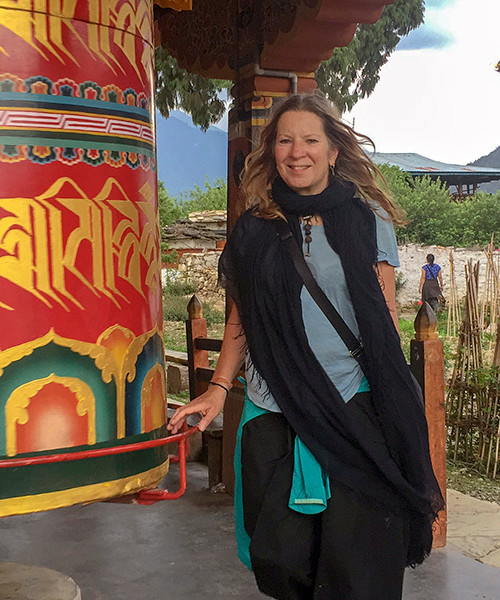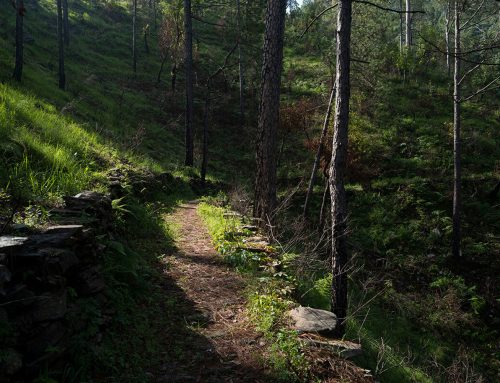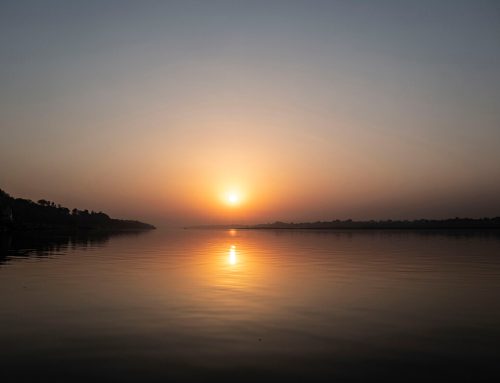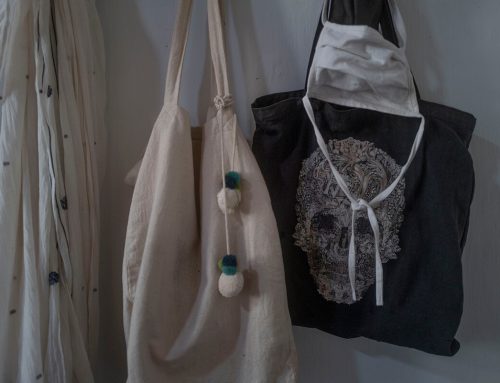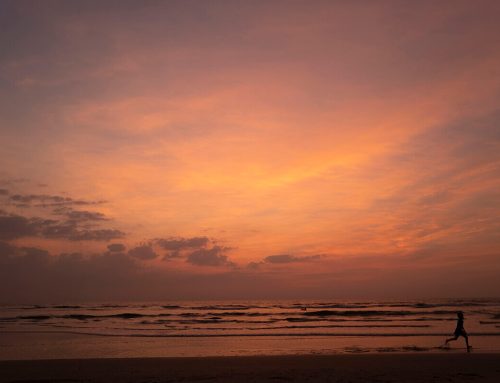Shambala Guesthouse becomes my sanctuary as the world becomes more confusing. I take solace in friends and animals, contemplate the impermanence of life and register my moral compass towards a Covid truth.
Photographs and text by Heather Elton
SHAMBALA IS A LOVELY, IMMACULATE GUESTHOUSE AT THE END OF A NARROW ROAD IN THE SMALL RURAL VILLAGE OF CAMURLIM. It is aptly named after the mythical Tibetan kingdom. Over the next five months, my life continues along three main tendrils – play (nature,) practice (yoga and spiritual sadhana), and creation (writing and photography). Shambala is surrounded by paddy fields with abundant bird life – Great Hornbills and peacocks fly into trees and Egrets land on backs of water buffalo. I’m close to the Chapora River and north Goa beaches, and there are lovely walks through cashew forests on a small mountain. On the road to Shambala there is a place around a natural spring where my body drops in temperature and I feel immersed in cool Shakti energy. I bring Rajita here on Sundays where she can experience new scents and sensations. I love riding the scooter on winding roads, through picturesque Hindu and Portuguese Catholic villages, and take the old ferry across the Chapora River to explore the other side. There are mangroves and locals gathering prawns. I visit temples and churches some built high up on a hill with a spectacular view towards the river and sea. The Vayu Farmer’s Market in Mandrem is a weekly event, followed by a swim in the sea at Mandrem beach. I’ve downsized back to a large studio flat and, after the disruption of moving, get back into my practice and writing. I’m able to maintain my focus and write an essay, Who is Gautama Buddha? for my blog. And I begin to take private, online, Hindi classes.

One of the reasons I moved here is that I need be around people again. I’m an introvert and it’s easy for me to be alone. I need to shake that up and change my habitual patterns. I cherish my friendships and how we witness to each other’s lives. Friendships are a tendril that continues through time. Shambala is quiet – other than the howling rhapsodic dogs and the rooster next door that I contemplate murdering with a hatchet. There are only three other guests, plus the Swiss German owners, the helpful and trustworthy staff, three dogs (Heidi is lying doing her best to replace Rajita) and two cats. All foreigners in India are legally allowed to stay until 30 days after commercial flights resume to/from India. I celebrate being in India for eight months and purchase a traditional Rajasthani charpai (day bed), beautifully strung with sisal and with four chunky wooden legs. It reminds me of a more romantic time on the subcontinent.
 Shambala is a beautiful guesthouse with a shanti vibe surrounded by rice fields, canals and mangroves of inland Goa.
Shambala is a beautiful guesthouse with a shanti vibe surrounded by rice fields, canals and mangroves of inland Goa.
While I’m at Karma Collection I see two exquisite Nepalese hand-carved Buddhas and buy them on the spot. Shakyamuni Buddha stands with his right hand in Abhaya Mudra (the gesture symbolises reassurance and safety, and dispels fear through divine protection and bliss) and his left hand in Dhyana Mudra signifies the female left-hand principle of wisdom and the removal of ignorance (avidya), or the misconception that things are permanent and solid. The second Buddha is both the loving and compassionate feminine form of Tara, or the male form of Lokeswar / Avalokiteshwara / Prajnaparamitra, sensuously carved and decorated in Sambhogakaya ornaments including a garland of skulls, and emanates compassion and wisdom. Tibetan and Hindu deities often manifest in different forms and are gender fluid.
 Shakyamuni Buddha stands with his right hand in Abhaya Mudra, the mudra of fearlessness. His left hand is in Dhyana Mudra which removes illusion. Om Muni Muni Maha Muni Shakyamuniaye Swaha.
Shakyamuni Buddha stands with his right hand in Abhaya Mudra, the mudra of fearlessness. His left hand is in Dhyana Mudra which removes illusion. Om Muni Muni Maha Muni Shakyamuniaye Swaha.
Many people can’t relate to deities thinking they are too far-fetched or fantastical with their seven eyes, eight arms, flying on the back of pregnant tigress, that sort of thing. Or, in the Hindu tradition where the elephant god Ganesh is depicted riding on the back of his divine vehicle, Pachasana, the rat. It defies logic. The purpose of this is to shake up our rational and conditioned view of reality seen through the lens of duality.
I bring the Buddhas home and give them an honorary spot, outside my door, where they are bathed in golden light at magic hour. Each morning I make flower offerings from the exotic trees growing in the garden. Naj Champa is my favourite scent. The deities are so beautiful that I’m certain they are none of than Buddha himself. Objects of divine devotion. But, not only do I try to see them as the Buddha; but an enlightened mind would recognise the qualities of a Buddha in all sentient beings. It helps me to feel more compassion and be kinder to everyone. My job is to develop confidence that my own true nature has exactly the same potential as that of the Buddha. Ultimately, the most supreme method is Guru Yoga. When the inner guru merges with the outer guru and that the guru dwells in your heart. Mixing your mind and the mind of the guru. Of course, devotion is difficult because I often feel a lingering sense of doubt that this really works. I need to trust Dzongsar Khentsye Rinpoche when he says that the cultivation of devotion and longing is important; and is a shortcut to enlightenment. I truly feel that the power of prayers, aspirations, and good wishes helps me change my perspective on the world.
 Depending on your perception, the second Buddha is either the feminine form of Tara, or the male form of Lokeswar / Avalokiteshwara / Prajnaparamitra, decorated in Sambhogakaya ornaments, emanating compassion and wisdom. Tibetan and Hindu deities often manifest in different forms and are gender fluid.
Depending on your perception, the second Buddha is either the feminine form of Tara, or the male form of Lokeswar / Avalokiteshwara / Prajnaparamitra, decorated in Sambhogakaya ornaments, emanating compassion and wisdom. Tibetan and Hindu deities often manifest in different forms and are gender fluid.
The Buddhas arrive at the perfect time. Dzongsar Khentsye Rinpoche has requested that we collectively do a million Shakyamuni mantras. Perhaps the most famous depiction of Shakyamuni, or Gautauma Buddha, is seated under the Bodhi Tree when he ‘awoke,’ and realised that all form, including our flesh and bones, and all our emotions and all our perceptions, are assembled. When any two components or more come together, a new phenomenon emerges—nails and wood become a table; water and leaves become tea; fear, devotion and a saviour become God. This end product doesn’t have an existence independent of its parts. Their character has changed and, together, they have become something else. They are ‘compounded’. Believing that things truly exist independently is the greatest deception. Thus, Siddhārtha discovered that impermanence means change. Anything that changes in relation to another thing is subject to the laws of impermanence. Our problem is that we want to solidify everything and try to make it permanent.
At the moment of his spiritual awakening, Māra (Lord of the Desire Realm) asked, ‘How will anyone believe you?’ Buddha touched the ground with his right fingers in Bhumisparsha Mudra, and summoned the Earth to be his witness. Touching the earth signifies the Truth. It’s a gesture of humility that both honours the earth and allows us to ‘touch base’ with our naked, raw mind. We become entirely present and the mind is no longer distracted. The mantra of Śākyamuni Buddha is:
TADYATHĀ OṂ MUNE MUNE MAHĀMUNAYE SVĀHĀ or TADYATHĀ OṂ MUNE MUNE MAHĀMUNE ŚĀKYAMUNAYE SVĀHĀ.
 Morjim Beach at sunset.
Morjim Beach at sunset.
At times during the pandemic the world feels wobbly. It seems to tremble in all directions. Whether this manifests as personal fear from the uncertainty in our own lives, or the increasing intolerance and hatred whipped up by mainstream media, (certainly around Donald Trump and the elections in the USA), that leads to the crumbling of cherished institutions. All this creates a kind of a stirring where it feels like the world lacks essence. Bhumisparsha Mudra has the effect of suppressing. When something is fluttering, it’s an antidote, like putting a weight on the thing, to ground it and touch base with reality, with the Earth. As a result, I feel much more grounded and fearless in the face of the pandemic.
Shakyamuni Buddha gave lots of teachings, including that we have no control over our life. We are totally dependent on the causes and conditions. We forget that we are as fragile as a dewdrop on a blade of grass. We can die at any moment. Our prosperity and beauty seems beautiful and intact, but it’s as illusory as a rainbow. When I take refuge in the Buddha really I’m surrendering to that truth. I accept the three marks of existence: anicca (impermanence), dukkha (unsatisfactoriness) and anatta (non-self). Nothing I imagine, or see or hear, nothing that I perceive externally, or internally, exists truly or independently. Impermanence is so obvious, but we just don’t see it.

 Rajita loves to cool down in the rice paddies and wander through the lush green rural Goa.
Rajita loves to cool down in the rice paddies and wander through the lush green rural Goa.
My rational mind likes to think that the outer world is real and solid. But that is not true. This is the fundamental realisation that most yoga teachings lead to, but the Buddha pointed out that this misperception is the cause of suffering. I practice ‘seeing’ reality as being like a dream. Or a film projected by my own mind. Everyone see things through the stain of their own perception. And the world media and governments also have biases.
Obviously, it’s not easy to take this view off the mat and in all moments of waking life. It’s a relentless investigation of mind. I have to be vigilant. Sometimes my mind feels stuck in the envelope of ‘me-ness’; trapped in my own narrow perspective. When it’s rigid and distracted, when I get stuck on a thought, idea, option, emotion, sensation, or anything that entangles me and forces me to see the world from the dualist view of me-ness, I train my mind to let go. Self-clinging and selfishness makes a mind rigid. I try to make my mind do the opposite of the way it likes and do things that take me out of my comfort zone to loosen this vice grip of I-ness. It’s a bit like Pratipaksha Bhavana in the asana practice where you do an opposing action to find the resistance or stability in the pose so that a sense of effortless, or spaciousness can arise. Every time a negative thought arises, I try to cultivate the opposite. Any thoughts emanating from self-cherishing cause more suffering. My motivation is to help all sentient beings get out of suffering.
One of the most effective methods is simply sitting. Samatha. If I’m depressed, upset, angry, planning, or have insomnia, then I count thoughts, and this does something to the flow of the mind. I count my breath, or repeat a mantra, to intentionally derail my mind. These practices change my habitual patterns. If I can catch the moment when my mind is relating to the past, future or present a change has occurred and the grip of my mindset loosens, so I can feel more open and at ease.
If I realise that I can’t concentrate – that is good too. When I become aware of the frustration I see the machinations of my mind. I catch myself contriving and fabricating, trying to dwell in the past or project into the future, and then watch when my mind simply rests in the present moment, without judgement. No thoughts. To simply be. Authentically present. The classic problem that happens for even the most seasoned practitioners, is not being able to trust the simplicity.
I try to see whatever arises in my mind. And catch the moment when I recognise a thought exists. If I don’t observe the thought, it creates more thoughts and writes a story. You only have to sit in mediation for a few minutes to see one thought attach itself to another, and suddenly a narrative unfolds before your eyes, laden with emotion and sensation.
We get entangled in our likes and dislikes, believing our preferences is a result of refined taste. If we remain stuck in our past habits, we get entangled in things like identity, gender, ideas and opinions, relationships, work, and attachment to possessions, believing that they define who we are. Sometimes these thoughts become scary experiences. Our mind is frightened. To observe is not to get entangled. And, it can be done anywhere, not just sitting up straight on a cushion. The idea is to bring the practice into everyday life and live each moment with that kind of awareness. Life as a path. Otherwise, what’s the point of being a good yogi during the meditation and then completely losing it when you’re not practicing?
 Monsoon sea at Galibag Beach in South Goa.
Monsoon sea at Galibag Beach in South Goa.
Sadhana practice allows me to shake things up even more. Both Shaivite and Buddhist tantric traditions train the mind to see everything as an illusion, and to recognise emptiness when we generate a deity through visualisation. A deity has a mirage-like essence, as if it’s made of light, both appearing and being empty of form. Before a thought bombards and entangles me, I distract myself with the form of the deity. A sadhana ends by dissolving the deity into a seed syllable, which also dissolves back into shunyata (emptiness). It’s a perfected, centuries-old, method to see the truth. My concentration skills are enhanced, the flow of consciousness changes direction and imprints new patterns, the groove of samsara dissipates, and I am reminded continuously to be aware of the construction of my thoughts.
But, even with an understanding and confidence in the Mahayana view, where the Buddha taught The Heart of Perfection and Wisdom Sutra, also known as the Prajñāpāramitā, that emphasises emptiness (Śūnyatā) and compassion (Karuna), devotion is difficult because doubt inevitably arises. The Buddha said that doubt is necessary as we should question everything to develop discernment and have a critical mind. The essence of the Prajñāpāramitā is: “Form is emptiness; emptiness is form. Emptiness is not other than form; form is no other than emptiness. In the same way, sensation, recognition, conditioning factors, and consciousness are emptiness.” This doubt, as well as an ever increasing ability to see ‘emptiness,’ accompanied by a falling away of the attachment to an inherently existing self and phenomena, has influenced my perspective on Covid.
 Pirate, the one-eyed cat, takes a nap.
Pirate, the one-eyed cat, takes a nap.
I’ve tried to keep myself informed about Covid-19 by researching wide-ranging perspectives from science to mainstream media, alternative narratives, and conspiracy theories, in an attempt to have discernment around the ‘official narrative’ and construct my own view. And that’s not easy. It’s a political minefield. Even the most gifted journalists and virologists are still flawed human beings with biases. World media and pharmaceutical companies are no different. Covid truth lies obscured in a complex web of lies.
Whether I read The Guardian or New York Times, scroll through social media, or listen to a podcast, I realise that there is always an agenda or a bias to the reporting. Journalists used to just report the facts so we could make up our own mind, now they tell us what to think. They editorialise, rather than just tell the truth. And this is what happens when world media conglomerates have members of pharmaceutical companies on their boards. The relationship between world media, Big Pharma, and big advertisements, possibly prevents truth from being conveyed. Truth might not be the primary agenda when $5 million is spent on advertising for vaccines. Think of the profits being made by Pfizer. All media has vested interest that tries to persuade you to follow their interests or commercial investments whether it’s the effectiveness of masks or RT-PCR tests, the 24/7 reporting of positive case numbers that whips up fear in the viewer, not separating co-morbidity deaths from Covid deaths, not reporting Covid deaths numbers alongside other causes of deaths like cancer, heart attacks, car accidents, domestic gun deaths in the US to get a better understanding of the gravity of the virus, or how big tech and billionaires like Bezos and Musk profit from Covid while ordinary humans lose their jobs, the promotion of experimental vaccines while suppressing discussion around preventative medicine or alternative therapies, polarising the debate so that anyone who is reluctant to have a vaccination is seen as ‘anti-vaxx’ (despite having every other safe and tested jab), pharmaceutical companies indemnified from vaccine injuries and the Gates foundation profiting off vaccine patents, the rumour of vaccine passports, to deflection of the origins of Covid and the ‘gain and function’ virologist experiments in the Wuhan lab supposedly funded by the US, and the censorship of this story by Facebook, weaponising the virus with track and trace and the potential loss of individual freedoms, and increasing government surveillance and lack of privacy. The list is exhaustive.

 A walk through a cashew forest and along the mangroves are part of living in Camurlim.
A walk through a cashew forest and along the mangroves are part of living in Camurlim.
The world has become so politicised it seems like we’ve lost our sense-making abilities. There might be no Plandemic but still questions need to be asked. It would be very convenient if there was one truth. If you could trust the massive vaccine stakeholders like WHO, CDC, NASID, Bill Gates, or your government. Unabashed corporate greed has insidiously undermined governments, universities and media. Our governments have proven themselves to be dishonest and profiteering. Boris Johnstone deliberately avoided putting India on the travel ‘red list’ prioritising trade talks with India, a trip that was inevitably cancelled. Our cherished institutions are crumbling around us, along with any sense of trust. Truth is in tatters. Yet, people still prefer to trust authority rather than take responsibility for their own life. The moral compass no longer registers true North. We need to find our own truth.
And the way to begin to find Covid truth, regardless if you believe in the official Covid narrative or Conspiracy Theory is your religion, if you believe science is god and only read peer-reviewed academic papers or scientific journals like The Lancet, is to see that all the stories have a bias. And, if they have their own interests at heart, only one shard of the truth can be seen. Ask yourself how much you want to allow others to determine what you think and how you live. Be resilient and focus on your inner authority. Each one of us has a different pandemic experience. There is no one truth. One of the most challenging things during the pandemic is holding many conflicting thoughts in my mind.

On my walks insubstantial things begin to appear. A reflection in a well with red dragonflies darting through air, dipping into water which is the sky. A rainbow after the rain. The reflection of the full moon shimmering in water. Shadows of leaves projected onto fallen leaves on the forest path. I love the intersectionality of illusion. I obsessively take photos of reflections to challenge perception of what is more real, the object or the reflection of it. The ephemerality is obvious, yet my mind still wants to perceive them as solid. I make it my mantra not to fall into any polarised views, or conspiracy theories, such as permanence. Of course, this is not easy to do. Habitual patterns run deep. That’s why I continue to offer flowers and cultivate devotion towards my Buddhas, as it helps me see them as being the deity, and treat them as precious objects, as I should everyone else. We are all Buddha.

It’s so beautiful here in Goa it sometimes hurts. I learned a new Hindi word today for sea. Samudra. Mudra means gesture. I think of the sea embracing me. This extends to everything. When I immerse myself in the Shakti vibration of ancient forests, or the mesmerising sunsets, the tenuous membrane that separates me from the five elements dissolves and I feel them in my heart. Bliss! I’m living inside a perfect dream, yet there is a sinister undercurrent. On the surface Goa appears to be Covid free. Modi hasn’t uttered a word about the pandemic since August. The Goan government insists lockdown is bad for the economy. Businesses have been open for months. Bars and restaurants are heaving. Beaches are crowded again but this time with Indian tourists. A Holi party is being prepared with over 1000 guests. The Shambala owners invite their friends for pizza parties and play a game of boules twice a week. Four million domestic tourists descend on Goa over the holiday season. And yet, Covid cases have not risen.
 I teach yoga ‘in person’ to a few guests at the Shambala pool and it’s great to adjust people in the asanas.
I teach yoga ‘in person’ to a few guests at the Shambala pool and it’s great to adjust people in the asanas.
I’m asked to teach yoga to a few guests by the pool. I have a PCR test. Negative. It’s lovely to teach in person again and adjust people, which has always been one of my favourite aspects of teaching yoga. One person in her mid-fifties, who has spent the past 25 years in front of a computer with a demanding and stressful job and much responsibility in her life, is experiencing chronic neck, shoulder and back pain. After a few classes she is feeling the benefit and her pain has subsided. She recommends me to a couple of her wealthy Indian friends.
Until now, I’ve never not taught someone because of money. I’ve done plenty of charity work, including teaching homeless people for Crisis in London, addicts at the Westminster Drug Project, and have taught Nath Aghori yogis, chelas of my guru, as seva in Nepal. But my sole income is from teaching yoga. I don’t have a rich husband. All my international retreats, training and Himalayan Yoga Adventures have been cancelled in 2020 and 2021. I’m extremely grateful to be in India. From a financial p-o-v, my living expenses have been reduced by a quarter and as a result I can survive. I’ve charged £100 for a private yoga class in London since 2006, so I feel 2500 INR (£25) is a fair price in India and is going rate for yoga in Goa for a private class.
 Restorative asanas are beneficial during the pandemic as they help to calm the mind and enhance the immune system.
Restorative asanas are beneficial during the pandemic as they help to calm the mind and enhance the immune system.
I want to share my experiences about teaching yoga to wealthy Indians in India. Two young women have just finished an on-line Sivananda training and are keen to learn more. One is a psychiatrist still working online with US clients who are paying top dollar and the other runs a successful business in India. I scooter 30 minutes to a luxury flat, teach a 90-minute class, stay a bit longer to answer questions and scooter home. Total time 2.5 hours. They want to pay me 800 rupees between them. That is £4 each. I know they spend 3000 INR on a 90-minute massage as we have the same therapist. I ask her if, as a business woman, she only hopes to make 800 rupees a class, after teaching for nearly 20 years, practising for close to 40 years, and spending thousands of dollars on classes, workshops and trainings. Is that really as good as it gets? I now realise that most Indians think yoga should be free, probably thanks to Baba Ram Dev and his free yoga classes on TV. I tell them that my time is worth more and, honestly, I’d rather go for a swim. They come back to me a few days later offering £1500. I still refuse. I don’t need to do it. It might be different if I was a new teacher and needed experience. But I don’t. I wish I could say this is an isolated incident but it isn’t.
 Pirate, the one-eyed cat in the props bag.
Pirate, the one-eyed cat in the props bag.
Another guest at Shambala claims my class is the best yoga class that she’s ever had. My spider sense tingles as I remember somewhere in the ancient texts we were warned to take everything, praise and scorn, with a grain of salt. I try to be diplomatic and offer a public class to keep everyone happy. Things get complicated when the other guests don’t want to do yoga with her. They want a private and are willing to pay my fee. This person (the daughter of a rich industrialist Jain family) feels that she too should have private class. No problem, except that she only wants to pay 300 INR (£3). When I tell her my mornings are too precious and I don’t want to teach for that amount, she has a meltdown and leaves me a hate message on voicemail calling me a white supremacist, racist and fake yoga practitioner. I marvel at how I have gone from being the best yoga teacher on the planet to the worst in a matter of days, but that is the nature of an unruly mind. I should have taught her out of an act of compassion.
 Milo imitating Nandi (Shiva’s vahana).
Milo imitating Nandi (Shiva’s vahana).
But what is the lesson in this? For clarity, always establish your rate at the outset. I did in London, but during the pandemic I’ve become more flexible, in response to people not working – to a point. I ask people to pay what they can afford based on how much they value their health and sanity. Time and time again, I see that material possessions are worth more.
In early March, I decide it’s time to practice travelling again. I’m not keen on spending another monsoon in Goa. I don’t mind the rain, but the intense heat and humidity of April and May are too extreme. I’m a Northerner. Ever since reading Gita Mehta’s book, A River Sutra, I’ve wanted to visit the tiny temple town of Maheshwar, on the sacred Narmada River, in Madhya Pradesh. It’s a two-hour direct flight from Goa. I think of it as a test journey before a more complicated trip to the Himalayas. ♦
Missing the beginning? Start with My Pandemic Life in India: Part One – Morjim, Goa
In January 2020, I pulled the rug out from under my comfort zone and left London to live in India. A month later the Covid pandemic ravaged the planet. I decided to stay in India. Photography, travelogue and memoir is used to share my experience as a travelling yogini and how spiritual practice helped me to stay grounded in challenging times. As always, deep gratitude to my guru, Dzongsar Jamyang Khentsye Rinpoche, for his presence and teachings. 🙏🏽 Any misrepresentations of facts or dharma are totally of my own doing for which I’m sorry.

